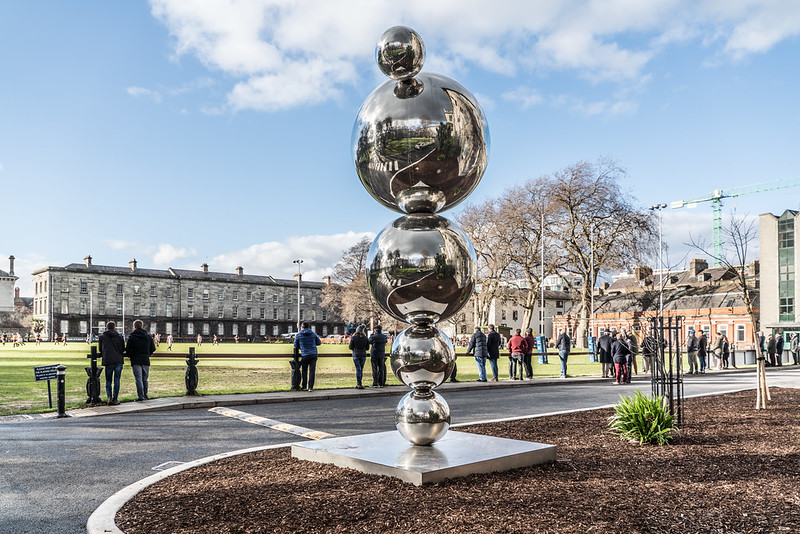
Few people are unfamiliar with the inimitable “Apples and Atoms” artwork on campus, but many don’t know it’s name, let alone the story of how it came to be – and the famous physicist it honours.
What Is It?
“Apples and Atoms” is a sculpture by Irish artist Eilís O’Connell. It is installed outside the Fitzgerald Building. The piece is a freestanding stainless steel work that deliberately reflects planted apple trees in the adjacent physics garden, and was commissioned in 2013 by College to celebrate the life and work of Prof Ernest Walton, a Nobel Laureate and Trinity Fellow. The main body of the work is just over four metres high, consisting of five mirrored spheres, which increase in size as they rise in height.
Who Made It?
Eilís O’Connell was born in Derry in 1953. She studied in the Crawford School of Art in Co Cork and the Massachusetts College of Art in Boston, specialising in sculpture. One of Ireland’s foremost sculptors, she is a member of the Aosdána, and her work has been displayed in the Venice, Paris and Sao Paulo Biennales exhibitions. Her small sculptures were shown at the Guggenheim Museum in Venice. “Apples and Atoms” is arresting of its own accord – it’s bright and alien in the surroundings of the 18th-century physics building, and the inspiration for the shape of the sculpture has been abstracted from the work of Walton, whom it commemorates.
Why Should I Care?
Walton is one of Trinity’s most esteemed graduates, and is considered one of the forefathers of modern physics. He and John Cockcrof were the first people to split the atom in 1932, an achievement that earned them the Nobel Prize. O’Connell abstracted this to create her column of reflective spheres, which by their size invite interaction – it’s hard to pass the sculpture without seeing people taking selfies of their distorted reflection.
The collaboration that the work invites from passersby, and the apple trees that it reflects, are a wonderful dedication to Walton as an individual as well as a scientist.
Outside of his work, he was a keen gardener, as well as a committed educator of the masses before it was in vogue to be. This work clearly encompasses three aspects of Ireland’s only Science Nobel Laureate. It is a fitting dedication, in both inspiration and physical size, to one of the giants of modern physics.






